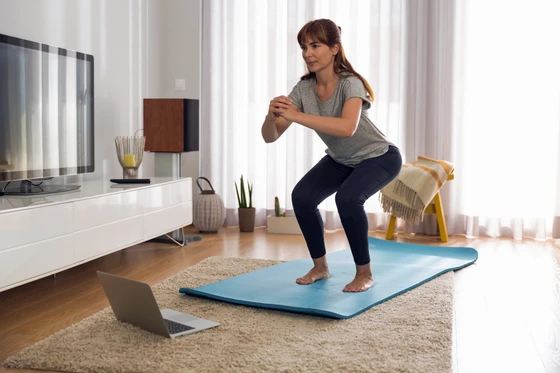After the last two blog posts in our ACL awareness series, today we address what everybody wants to know…What exercises can I do to prevent an ACL injury?
Having an exercise routine that focuses on improving function in the following categories can reduce the risk of suffering an ACL injury:
- core/trunk stability
- strengthening
- plyometrics and jump training
- running/agility
- flexibility
There are hundreds of exercises that can fall into each category, but these are P3 Athletic’s favorites, along with their progressions (or variations based on strength and skill level)!
Disclaimer: Always check with your health provider before beginning a new exercise regimen.
Core and Trunk stability: BRIDGE
If done CORRECTLY, the bridge is a powerful exercise. It strengthens your glutes, hamstrings, and core all in one! When these areas are strong, they can take on the force of both non-contact and contact impact to your body and help protect your knees and ACL from injury.
How to do a bridge + progressions:
Tips for getting it right:
- Draw the belly in towards the spine without lifting your chest or holding your breath. This engages core muscles and keeps your spine in the ideal position throughout the exercise.
- Focus on pushing force through your foot, rather than trying to lift up your pelvis.
Progressions:
Here are some variations of the bridge that we use to make the exercise more challenging.
- Add a resistance band wrapped around the knees
- Place and hold a weight on the pelvis
- Perform the exercise on one leg
Strength: SQUAT
This might be considered the King or Queen of all lower body strengthening. Not only does it strengthen ALL of the muscles in your lower body, but it’s another tool to train proper movement mechanics to avoid the 5 risk factors of ACL injury.
How to do a squat + progressions:
Tips for getting it right:
- Keep each knee aligned over the second toe on each foot. If you’re looking at yourself in the mirror, you should be able to draw a straight, vertical line from the kneecap to the second toe.
- Keep your hips back which engages the glute muscles and promotes better jumping and landing form, taking the force off the knee and ACL.
Progressions:
Here are some variations of the squat that we use to make the exercise more challenging.
- Weights! Dumbbells, kettlebells, barbells, holding a heavy bag, kids on your back, you name it – if it adds more weight to your squat, you’re getting stronger!
- Single leg squat: Essentially twice as much weight as a regular squat
Plyometrics and Jump Training
Plyometrics is a type of exercise training involving repeated stretching and contracting of muscles (as by jumping and rebounding) using speed and force to build muscle power. I probably don’t need to tell you what jumping looks like. However, since many ACL injuries occur while jumping in sport, it’s essential to teach, practice, and train how to do it properly to minimize ACL stress.
What are examples of jump training and plyometrics?
Tips for getting it right:
- While jumping, allow the knee and hip to bend equally and simultaneously as your foot hits the ground
- Make sure both feet hit the ground or leave the ground at the same time.
- If doing single leg jumps, make sure the trunk/torso stays upright and doesn’t lean over to one side.
Progressions:
Here are some variations of jump training and plyometrics.
- Drop squat: This exercise helps us learn to control landings and a precursor for plyometrics
- Box or step. This will develop the power and acceleration
- Plyometrics: Jumping down from a box/step and immediately jumping up to a target or onto a box
Agility: SKATERS
Similar to jumping movements, a lot of ACL injuries occur during sports and movement that require fast stopping, accelerating, and change of direction. For that reason, practicing and training these movements properly is essential. Skaters are great because they focus on building and maintaining the stability and strength required to put full body weight on a single leg, in a lateral direction, much like most sports require.
How to do skaters + progressions:
Tips for getting it right:
- Knee does NOT dive inward when pushing off or landing
- trunk/torso does not fall outside of the foot
Progressions:
Here are some variations of skaters that we use to make the exercise more challenging.
- Land on soft surface to challenge balance and stability
- Have someone toss a ball to you upon landing and throw back
Flexibility: HAMSTRING SCOOPS
With dynamic stretching, the goal is to warm up the muscle and tissue, increase the available range they can work in (flexibility), and practice proper form and mechanics. Hamstring flexibility is a common limitation for many athletes. Unfortunately, this prevents them from moving with good biomechanics and puts the ACL at risk.
What are walking hamstring scoops?
Tips for getting it right:
- When bending forward, hinge from the hips to get maximum hamstring stretch and contraction
- Over multiple reps you should be able to reach further
There’s more where these come from
As you’ve probably seen on your Facebook, Instagram, or Youtube, there are many exercises that are designed to help prevent ACL injuries and strengthen the knee. These are some of our favorites, and if you were to work with any of us at P3 Athletic, we would work with you to develop a training program unique to your athletic demands.
If you’d like to get more info on ACL prevention and earn a chance to win an ACL prevention assessment with a CUSTOMIZED plan, join us on Wednesday, April 5th at 5:45pm for our free ACL injury awareness seminar. SIGN-UP HERE.
Need help from our team now? Request a call with our care coordinator to set up a complimentary session with a P3 doctor of physical therapy.

